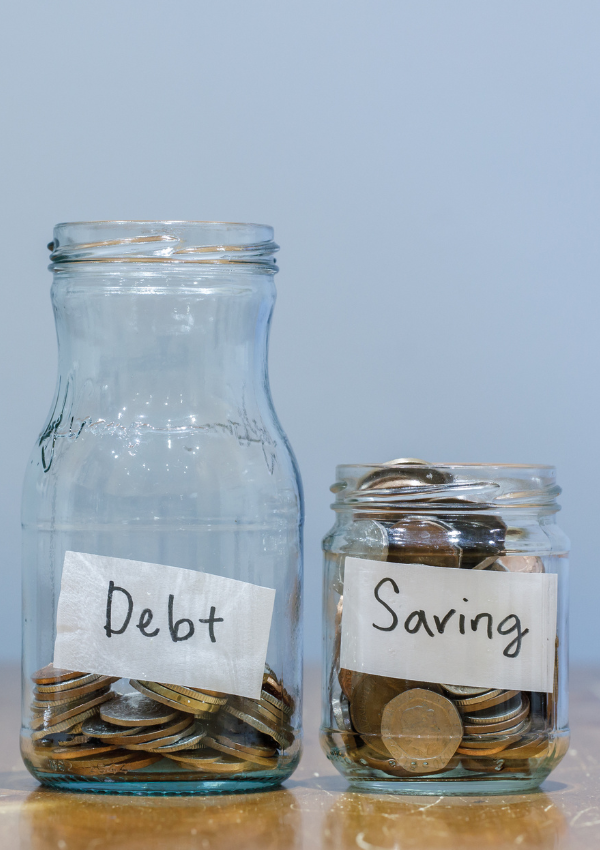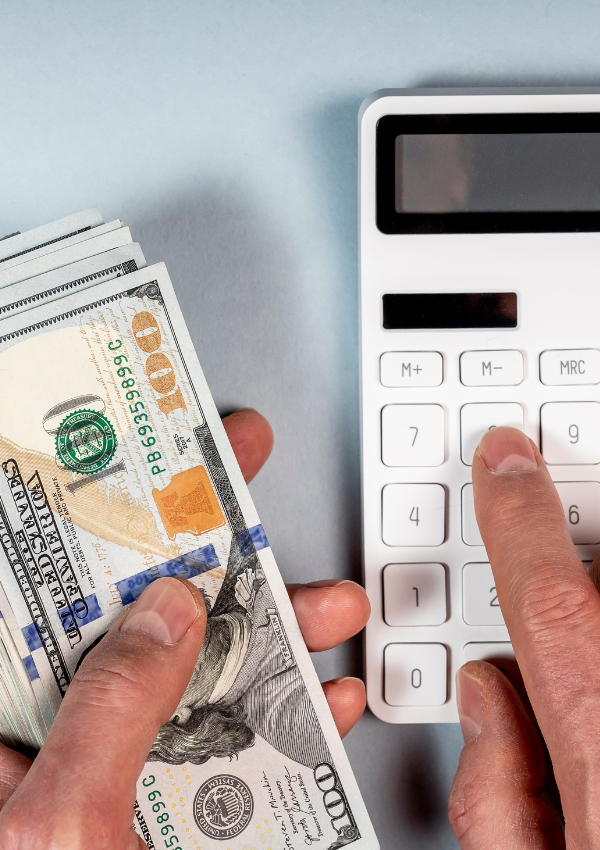Picture this: you’re at a crossroad. On one side, there’s a path that leads to your financial future, full of positivity and growth. On the other, is a road filled with negativity and financial pitfalls. Welcome to the world of debt, where not all roads are created equal.
In this post, we will explore the crucial differences between good debt and bad debt, why it’s important to know, and how you can navigate your own financial journey with confidence.

Good Debt – Friend or Foe?
Debt can be a friend, only when it serves a purpose that enhances your financial well-being. Good debt offers a return on investment and helps you build a stronger future. Here’s a closer look at some examples of good debt, and why we believe they are good:
1. Mortgage Debt: Taking out a mortgage to buy a home is a prime example of good debt. It’s an investment in real estate, and over time, your property can appreciate, building wealth. While some mortgages are a bad decision, if made wisely, your mortgage debt can be a strong example of wealth building. As they say, you can’t make any more land.
2. Student Loans: Investing in education can be a wise choice. While student loans can be hefty, they provide the potential for higher earning power over your lifetime. By obtaining a degree or certification, you’re opening doors to career opportunities that can lead to increased income and financial stability. Just make sure that the cost will be reimbursed once you are in your career. A lot of people blindly take out student loans with no goal in mind, and this leads to the probability of bad debt rather than good debt.
3. Business Loans: If you’re an aspiring entrepreneur, a business loan can jumpstart your venture. It’s a risk that could lead to long-term financial rewards. By investing in your business, you’re aiming to generate profits that can ultimately outweigh the initial debt. It’s a strategic move that can pay off in the long run. As long as your net profits can cover the loan and interest, business loans are a positive debt asset to have.
4. Real Estate Investment Loans: Taking on debt to invest in real estate can be a form of good debt, as long as your do your research and net a gain. Whether it’s a rental property or a real estate project, it can generate rental income or appreciate in value, helping you build wealth over time, well past the amount of debt taken out.
5. Investment Loans: Borrowing money to invest in diversified portfolios, stocks, or retirement accounts can be a way to potentially grow your wealth. While it comes with risks, it’s considered good debt when the return on your investments surpasses the interest you’re paying on the borrowed funds. If you plan on taking out this type of debt, be smart about it and do your research.

Bad Debt – The Financial Quicksand
Bad debt, on the other hand, is like quicksand, slowly but surely pulling you down financially. There are typically no long-term benefits and this type of debt can hinder your financial progress. Here’s are some bad debts to be cautious about:
1. Credit Card Debt: Carrying high balances on credit cards, especially if you’re only making minimum payments, can lead to excessive interest charges. This debt often snowballs and can be hard to escape, especially with the astronomical interest rates. Credit card debt is a classic example of bad debt, especially when used for everyday expenses that you can’t afford to pay off in full each month.
2. Payday Loans: These loans come with high interest rates that trap borrowers into a cycle of debt. These should be avoided at all costs. Payday loans target individuals in need of quick cash, but the high interest rates and short repayment terms make them financially detrimental. Before you know it you could be in an endless cycle of using payday loans to pay themselves back.
3. High-Interest Personal Loans: While personal loans can be useful in some situations, high-interest personal loans can become a financial burden. These loans often come with interest rates that make it challenging to repay them, especially if you’re borrowing for non-essential purposes.
4. Auto Loans for Depreciating Assets: Financing a car with a high-interest auto loan can be a form of bad debt, especially if you’re purchasing a vehicle that rapidly depreciates in value. It’s essential to consider how your choice of transportation affects your overall financial well-being.
Are you seeing a pattern here? Avoid high interest and unnecessary debts at all costs. It will be detrimental to your finances, and with the high rates, it can be almost impossible to get yourself out of a debt cycle.

Key Distinctions Between Good and Bad Debt:
There are several key differences between good debt and bad debt, as listed below.
- Purpose: Good debt is invested in your future, while bad debt usually relates to past or impulsive spending. It’s about using debt as a beneficial tool for financial growth rather than indulgences.
- Interest Rates: Good debt often carries lower interest rates or offers some sort of tax benefit. Bad debt tends to come with high-interest rates that can quickly accumulate, making it a financial burden.
- Repayment Terms: Good debt often has manageable and structured repayment terms. Bad debt may have shorter terms and high monthly payments, making it extremely difficult to manage.

Navigating Debt:
Now that you know the difference between good and bad debt, here’s how to navigate the debt landscape effectively:
1. Prioritize Repayment: If you have high-interest bad debt, make it a top priority to pay it off. Focus on credit card balances, payday loans, and other forms of expensive debt. Create a debt repayment plan and commit to it.
2. Budget and Plan: Create a budget that helps you manage your expenses and allocate funds toward paying down debt. Include a debt repayment plan in your budget and stick to it. Setting clear financial goals, such as paying off a credit card or student loan, can provide motivation.
3. Emergency Fund: Build an emergency fund to handle unexpected expenses without resorting to high-interest debt. Having savings in place can provide peace of mind and reduce reliance on credit in times of financial need. This may seem difficult while you are also paying off debt, but trust me when I say it is worth it in the long run.
4. Financial Goals: Set clear financial goals, such as saving for retirement, a home, or education. This will help you make informed decisions about when to take on good debt. For example, if you’re considering a mortgage, ensure it aligns with your long-term goal of homeownership.
5. Credit Management: Keep a close eye on your credit score and credit reports. Maintaining good credit can help you access favorable interest rates and terms when you do take on debt. Regularly monitor your credit to ensure it’s accurate and reflects your responsible financial behavior.
6. Seek Financial Education: Invest time in understanding personal finance and debt management, especially for your personal situation. Read books, attend workshops, or seek advice from financial professionals. The more you know, the better equipped you are to make informed financial decisions.
7. Seek Professional Advice: If you’re unsure about your financial situation or the types of debt that are best for your goals, don’t hesitate to consult a financial advisor. They can provide personalized guidance based on your unique circumstances. Many local programs also offer resources for those in need.

Conclusion:
In the journey toward financial wisdom, understanding the difference between good and bad debt is critical. Good debt can be a stepping stone to your financial dreams, but bad debt can take you down a pitfall of financial devastation.
Embrace good debt when it aligns with your financial goals, such as homeownership, education, or starting a business. Exercise caution when it comes to bad debt, particularly high-interest credit card balances and payday loans. The key to financial success is informed decision-making and a proactive approach to debt management.
With the right knowledge and a firm resolve to manage your financial affairs wisely, you can build a stronger and more secure financial future. Debt doesn’t have to be a burden; it can be a tool for progress when used thoughtfully and strategically.
The distinction between good debt and bad debt is a critical one, and knowing it is important for your financial future. Embrace good debt when it can work to your advantage, but approach bad debt with caution and diligence.
Remember that it’s not just about avoiding debt altogether but making informed choices that support your long-term financial well-being. With the right perspective and financial wisdom, you can pave the way to a brighter, debt-free future using your new found financial responsibility.





[…] You are here because you are wondering how to pay off debt quickly. And I am here to show you! Debt can be detrimental to your finances. If you want to learn more about debt, check out our article on Good Debt vs. Bad Debt! […]